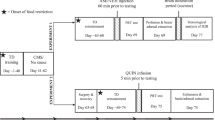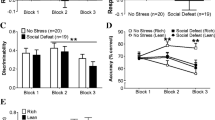Abstract
Rationale
Anhedonia, a deficit in reward processing, is an endophenotype of several neuropsychiatric conditions. Despite its prevalence and debilitating effects, treatments for anhedonia are lacking, primarily because its underlying mechanisms are poorly understood. Dopamine (DA) has been implicated in anhedonia through its role in reward-related learning; glucocorticoid systems may also be involved in that anhedonia is often preceded by chronic stress.
Objective
This study investigated DA and glucocorticoid systems in anhedonia using a rat version of the probabilistic reward task (PRT).
Methods
Adult male Wistar rats were trained on the PRT and then tested following: (1) activation or inhibition of DA activity induced by amphetamine (AMPH) or pramipexole (PRAMI) injections, (2) chronic mild stress (CMS), or (3) glucocorticoid system activation (dexamethasone (DEX)) or inhibition (mifepristone (MIFE)).
Results
AMPH increased and PRAMI decreased response bias, pointing to enhanced and diminished reward responsiveness with DA agonism and antagonism, respectively. CMS reduced response bias but only in a subpopulation of rats. DEX also decreased response bias, suggesting that glucocorticoid processes contribute to anhedonia, although glucocorticoid inhibition (MIFE) had no effect. None of the manipulations altered the ability to detect and respond to reward-paired stimuli.
Conclusions
These results confirm a role of DA in anhedonia and elucidate the contribution of the glucocorticoid system to this effect. In addition, chronic stress may interfere with normal DA functioning, leading to impaired reward-related learning in some animals. These findings may direct future treatment of anhedonia by targeting DA and glucocorticoid systems, as well as a possible interaction between the two.



Similar content being viewed by others
References
American Psychiatric Association (2013) Diagnostic and statistical manual of mental disorders, fifth edition, text revision. American Psychiatric Association, Washington, DC
Atherton BD, Nevels RM, Moore MT (2015) Predicting symptoms of depression from social anhedonia and emotion regulation. J Nerv Ment Dis 203(3):170–174
Bardgett ME, Depenbrock M, Downs N, Points M, Green L (2009) Dopamine modulates effort-based decision making in rats. Behav Neurosci 123(2):242–251
Barr RS, Pizzagalli DA, Culhane MA, Goff DC, Evins AE (2008) A single dose of nicotine enhances reward responsiveness in nonsmokers: implications for development of dependence. Biol Psychiatry 63(11):1061–1065
Beninger RJ, Phillips AG (1980) The effect of pimozide on the establishment of conditioned reinforcement. Psychopharmacology 68(2):147–153
Bergström A, Jayatissa MN, Thykjaer T, Wiborg O (2007) Molecular pathways associated with stress resilience and drug resistance in the chronic mild stress rat model of depression: a gene expression study. J Mol Neurosci 33(2):201–215
Berridge KC, Aldridge JW (2009) Decision utility, incentive salience, and cue-triggered “wanting”. Oxf Ser Soc Cogn Soc Neurosci 2009:509
Bisgaard CF, Jayatissa MN, Enghild JJ, Sanchéz C, Artemychyn R, Wiborg O (2007) Proteomic investigation of the ventral rat hippocampus links DRP-2 to escitalopram treatment resistance and SNAP to stress resilience in the chronic mild stress model of depression. J Mol Neurosci 32(2):132–144
Bisson JI, Jenkins PL, Alexander J, Bannister C (1997) Randomised controlled trial of psychological debriefing for victims of acute burn trauma. Br J Psychiatry 171(1):78–81
Bonanno GA (2004) Loss, trauma, and human resilience: have we underestimated the human capacity to thrive after extremely aversive events? Am Psychol 59(1):20–28
Bourke CH, Neigh GN (2011) Behavioral effects of chronic adolescent stress are sustained and sexually dimorphic. Horm Behav 60(1):112–120
Casarotto PC, Andreatini R (2007) Repeated paroxetine treatment reverses anhedonia induced in rats by chronic mild stress or dexamethasone. Eur Neuropsychopharmacol 17:735–742
Davis M (1970) Effects of interstimulus interval length and variability on startle-response habituation in the rat. J Comp Physiol Psychol 72(2):177–192
Der-Avakian A, D'souza MS, Pizzagalli DA, Markou A (2013) Assessment of reward responsiveness in the response bias probabilistic reward task in rats. Transl Psychiatry 3:297
Der-Avakian A, D’Souza MS, Potter DN, Chartoff EH, Carlezon WA, Pizzagalli DA, Markou A (2017) Social defeat disrupts reward learning and potentiates striatal nociceptin/orphanin FQ mRNA in rats. Psychopharmacology 234(9–10):1603–1614
Gambarana C, Masi F, Tagliamonte A, Scheggi S, Ghiglieri O, Graziella De Montis M (1999) A chronic stress that impairs reactivity in rats also decreases dopaminergic transmission in the nucleus accumbens: a microdialysis study. J Neurochem 72(5):2039–2046
Gillespie CF, Nemeroff CB (2005) Hypercortisolemia and depression. Psychosom Med 67:26–28
Gronli J, Murison R, Fiske E, Bjorvatn B, Sorensen E, Portas CM, Ursin R (2005) Effects of chronic mild stress on sexual behavior, locomotor activity and consumption of sucrose and saccharine solutions. Physiol Behav 84(4):571–577
Gronli J, Fiske E, Murison R, Bjorvatn B, Sørensen E, Ursin R, Portas CM (2007) Extracellular levels of serotonin and GABA in the hippocampus after chronic mild stress in rats. A microdialysis study in an animal model of depression. Behav Brain Res 181(1):42–51
Heikinheimo O, Kekkonen R, Lähteenmäki P (2003) The pharmacokinetics of mifepristone in humans reveal insights into differential mechanisms of antiprogestin action. Contraception 68(6):421–426
Henningsen K, Andreasen JT, Bouzinova EV, Jayatissa MN, Jensen MS, Redrobe JP, Wiborg O (2009) Cognitive deficits in the rat chronic mild stress model for depression: relation to anhedonic-like responses. Behav Brain Res 198(1):136–141
Isovich E, Mijnster MJ, Flügge G, Fuchs E (2000) Chronic psychosocial stress reduces the density of dopamine transporters. Eur J Neurosci 12(3):1071–1078
Jayatissa MN, Henningsen K, Nikolajsen G, West MJ, Wiborg O (2010) A reduced number of hippocampal granule cells does not associate with an anhedonia-like phenotype in a rat chronic mild stress model of depression. Stress 13(2):95–105
Keller J, Young CB, Kelley E, Prater K, Levitin DJ, Menon V (2013) Trait anhedonia is associated with reduced reactivity and connectivity of mesolimbic and paralimbic reward pathways. J Psychiatr Res 47(10):1319–1328
Krugel LK, Biele G, Mohr PN, Li SC, Heekeren HR (2009) Genetic variation in dopaminergic neuromodulation influences the ability to rapidly and flexibly adapt decisions. Proc Natl Acad Sci U S A 106(42):17951–17956
Lamontagne SJ, Olmstead MC (2018) Animal models in addiction research: a dimensional approach. Neurosci Biobehav Rev (in press)
Lighthall NR, Sakaki M, Vasunilashorn S, Nga L, Somayajula S, Chen EY, Mather M (2011) Gender differences in reward-related decision processing under stress. Soc Cogn Affect Neurosci 26:42
Linnet J (2014) Neurobiological underpinnings of reward anticipation and outcome evaluation in gambling disorder. Front Behav Neurosci 8:544
Lucas LR, Celen Z, Tamashiro KLK, Blanchard RJ, Blanchard DC, Markham C, McEwen BS (2004) Repeated exposure to social stress has long-term effects on indirect markers of dopaminergic activity in brain regions associated with motivated behavior. Neuroscience 124(2):449–457
Mahoney MK, Barnes JH, Wiercigroch D, Olmstead MC (2016) Pharmacological investigations of a yohimbine–impulsivity interaction in rats. Behav Pharmacol 27(7):585–595
Pariante CM, Lightman SL (2008) The HPA axis in major depression: classical theories and new developments. Trends Neurosci 31(9):464–468
Parker G, Fletcher K, Paterson A, Anderson J, Hong M (2014) Gender differences in depression severity and symptoms across depressive sub-types. J Affect Disord 167:351–357
Parkinson JA, Olmstead MC, Burns LH, Robbins TW, Everitt BJ (1999) Dissociation in effects of lesions of the nucleus accumbens core and shell on appetitive pavlovian approach behavior and the potentiation of conditioned reinforcement and locomotor activity by-amphetamine. J Neurosci Nurs 19(6):2401–2411
Pitman DL, Ottenweller JE, Natelson BH (1988) Plasma corticosterone levels during repeated presentation of two intensities of restraint stress: chronic stress and habituation. Physiol Behav 43(1):47–55
Pizzagalli DA (2014) Depression, stress, and anhedonia: toward a synthesis and integrated model. Annu Rev Clin Psychol 10:393–423
Pizzagalli DA, Jahn AL, O’Shea JP (2005) Toward an objective characterization of an anhedonic phenotype: a signal-detection approach. Biol Psychiatry 57(4):319–327
Pizzagalli DA, Iosifescu D, Hallett LA, Ratner KG, Fava M (2008) Reduced hedonic capacity in major depressive disorder: evidence from a probabilistic reward task. J Psychiatr Res 43(1):76–87
Pizzagalli DA, Holmes AJ, Dillon DG, Goetz EL, Birk JL, Bogdan R (2009) Reduced caudate and nucleus accumbens response to rewards in unmedicated individuals with major depressive disorder. Am J Psychiatry 166:702–710
Price J, Cole V, Goodwin GM (2009) Emotional side-effects of selective serotonin reuptake inhibitors: qualitative study. Br J Psychiatry 195(3):211–217
Rossetti AC, Papp M, Gruca P, Paladini MS, Racagni G, Riva MA, Molteni R (2016) Stress-induced anhedonia is associated with the activation of the inflammatory system in the rat brain: restorative effect of pharmacological intervention. Pharmacol Res 103:1–12
Santesso DL, Dillon DG, Birk JL, Holmes AJ, Goetz E, Bogdan R (2008) Individual differences in reinforcement learning. Neuroimage 42:807–816
Schultz W, Dayan P, Montague PR (1997) A neural substrate of prediction and reward. Science 275(5306):1593–1599
Slattery DA, Cryan JF (2017) Modelling depression in animals: at the interface of reward and stress pathways. Psychopharmacology 234(9–10):1451–1465
Song MR, Fellous JM (2014) Value learning and arousal in the extinction of probabilistic rewards: the role of dopamine in a modified temporal difference model. PLoS One 9(2):489–494
Spijker J, Bijl RV, de Graaf R, Nolan WA (2001) Determinants of poor 1-year outcome of DSM-III-R major depression in the general population: results of the Netherlands Mental Health Survey and Incidence Study (NEMESIS). Acta Psychiatr Scand 103(2):122–130
Strekalova T, Spanagel R, Bartsch D, Henn FA, Gass P (2004) Stress-induced anhedonia in mice is associated with deficits in forced swimming and exploration. Neuropsychopharmacology 29(11):2007–2017
Taylor JR, Robbins TW (1984) Enhanced behavioural control by conditioned reinforcers following microinjections of d-amphetamine into the nucleus accumbens. Psychopharmacology 84(3):405–412
Vrieze E, Ceccarini J, Pizzagalli DA, Bormans G, Vandenbulcke M, Demyttenaere K (2013) Measuring extrastriatal dopamine release during a reward learning task. Hum Brain Mapp 34:575–586
Willner P (2005) Chronic mild stress (CMS) revisited: consistency and behavioural neurobiological concordance in the effects of CMS. Neuropsychobiology 52(2):90–110
Willner P, Towell A, Sampson D, Sophokleous S, Muscat R (1987) Reduction of sucrose preference by chronic unpredictable mild stress, and its restoration by a tricyclic antidepressant. Psychopharmacology 93(3):358–364
Willner P, Muscat R, Papp M (1992) Chronic mild stress-induced anhedonia: a realistic animal model of depression. Neurosci Biobehav Rev 16:525–534
Winer ES, Drapeau CW, Veilleux JC, Nadorff MR (2016) The association between anhedonia, suicidal ideation, and suicide attempts in a large student sample. Arch Suicide Res 20(2):265–272
Wise RA (1980) Action of drugs of abuse on brain reward systems. Pharmacol Biochem Behav 13:213–223
Wit S, Dickinson A (2009) Associative theories of goal-directed behaviour: a case for animal–human translational models. Psychol Res 73(4):463–476
Wyvell CL, Berridge KC (2000) Intra-accumbens amphetamine increases the conditioned incentive salience of sucrose reward: enhancement of reward “wanting” without enhanced “liking” or response reinforcement. J Neurosci Nurs 20(21):8122–8130
Acknowledgements
This work was supported by operating grants from the Canadian Institutes of Health Research (CIHR) and the Natural Sciences and Engineering Research Council of Canada (NSERC) to MCO, and by an NSERC Alexander Graham Bell Graduate Scholarship to SJL. We thank Dr. Andre Der-Avakian and Amanda Shamblaw for comments on the manuscript, and Lisa Willberforce and Roland Dupras for technical assistance. Queen’s University is situated on traditional Anishinaabe and Haudenosaunee Territory.
Author information
Authors and Affiliations
Corresponding author
Ethics declarations
Conflict of interest
The authors declare that they have no conflicts of interest.
Rights and permissions
About this article
Cite this article
Lamontagne, S.J., Melendez, S.I. & Olmstead, M.C. Investigating dopamine and glucocorticoid systems as underlying mechanisms of anhedonia. Psychopharmacology 235, 3103–3113 (2018). https://doi.org/10.1007/s00213-018-5007-4
Received:
Accepted:
Published:
Issue Date:
DOI: https://doi.org/10.1007/s00213-018-5007-4




